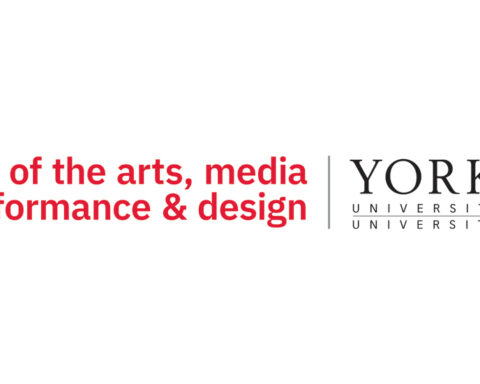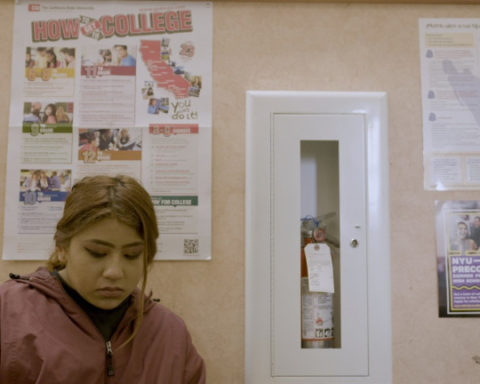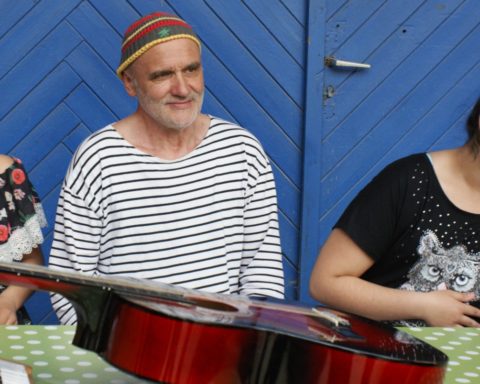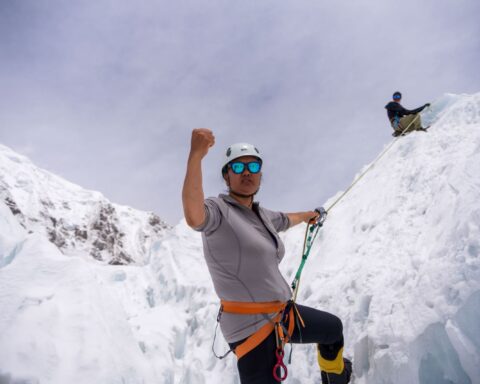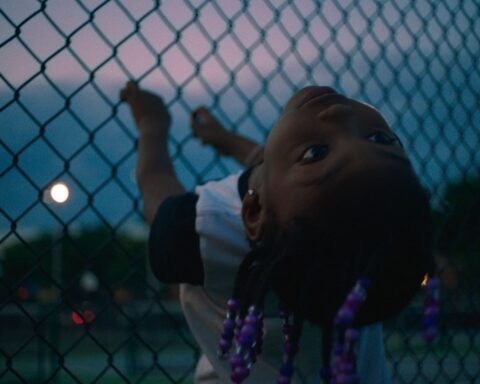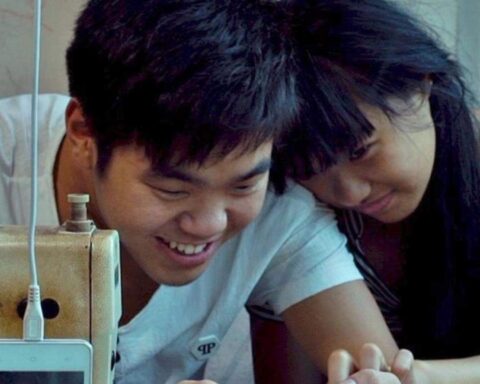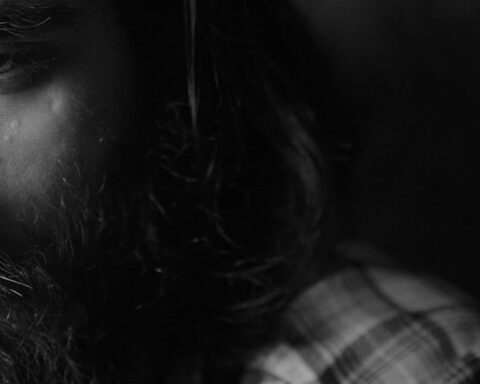RYERSON UNIVERSITY, SCHOOL OF IMAGE ARTS | TORONTO
Background information provided by Katy McCormick, MFA graduate program director/associate professor, Documentary Media MFA, School of Image Arts, Ryerson University
LEAD ROLE: Our main character Zariya, 25, is seen in a Vimeo video, introducing a short doc she has made about a set of female twins she knows. Clips set up their story, then we learn the twins become estranged. At the end of the video, viewers are presented with two separate URLs, each for a video following the fate of one of the twins.
This is Zariya’s visual portfolio submission for Ryerson’s MFA in Documentary Media program. She says she has a BA in film studies from another institution, but has decided to focus on documentary— from both theoretical and practical perspectives, with a particular interest in how digital interactivity has broadened the scope of what a doc can be.
ROLL CAMERA: In a theory class, Zariya gives a presentation about the NFB-New York Times collaboration Highrise as an ultimate example of a documentary project that is interactive, multimedia
and ever-evolving.
Zariya explains that for her thesis project she would like to make a multiplatform doc about efforts to protect ancient historical sites under threat from ISIS in war zones including Syria and Iraq, where her family is from.
She and the other first- and second-year students attend an exhibition at the Montreal Museum of Fine Arts as part of a field trip to Le Mois de la Photo à Montréal.
In Zariya’s second year, interdisciplinary artist Deanna Bowen guests at a Master Class seminar and screens one of her films. Zariya is among four students who then screen their work for Bowen.
Zariya attends a lecture in her elective class, Enabling Technologies and the Illusions of Knowledge: Studies in Culture and Perception. She explains she was attracted to its exploration of “culture wars” and new forms of propaganda, which she sees as connected to the kinds of videos ISIS distributes.
THE CHALLENGE: Zariya has shot so much compelling footage she’s finding it hard to keep her doc focused and at the requested 20-25 minute running time. Before the Christmas holidays she shows her teacher and classmates a rough cut of about 45 minutes. She absorbs their feedback.
She says she realises she has to go with her creative instincts, and based on what she’s learned about formulating a conceptual foundation and structuring her ideas, she retreats to the editing room determined to cut her film down to size.
THE SCREENING: Zariya types away on the support paper for her thesis project. On another occasion, she peruses online stock photos of some of the historical sites that have been destroyed or are in danger. She interviews a local academic expert on antiquities, conducting the interview while classmates handle the EOS 5D Mark II digital camera, as well as the lighting and audio recording. Via Skype, she records key interviews with overseas curators who are near the danger zones.
She has created a website where her doc resides. It also features a photo gallery of historical sites that have been destroyed or are in imminent danger and an interactive map outlining ISIS’ actions to date. Zariya premieres the 25-minute short film at Ryerson’s Doc Now documentary media festival, and the audience responds warmly to this exploration of cultural history threatened with extinction. She raises a glass with her graduating peers at the afterparty.
EPILOGUE: Zariya’s short film has helped her land funding for a feature-length version, which she proceeds to direct. She interviews a prominent U.N. official about the organisation’s measures to protect heritage sites. She receives further funding to enhance the companion website, working with a web designer.
Her educational experience was so positive that she goes on to study for her PhD, eyeing a career balancing teaching in the media arts with directing feature indie docs.
Housed in Ryerson’s School of Image Arts in Toronto, the MFA in Documentary Media is a full-time, two-year/six-term programme that strives to maintain a connection to documentary traditions while encouraging innovative approaches to the making of new documentary works.
SENECA COLLEGE, DOCUMENTARY FILMMAKING INSTITUTE | TORONTO Eight-month Documentary and Non-Fiction Media Production programme
Background information provided by Sun-Kyung (Sunny) Yi, program coordinator/professor, Documentary Filmmaking Institute & Documentary Non-Fiction Production programme, School of Creative Arts and Animation, Seneca College
LEAD ROLE: The film opens with main character Ryan, 23, explaining why he wants to attend Seneca College’s Documentary and Non-Fiction Media Production programme. He already has a BFA specializing in visual arts from another institution, but has decided on a career in documentary production. He likes Seneca’s focus on storytelling and technical and industry training in documentary, factual entertainment and multi-platform media.
ROLL CAMERA: We follow Ryan through the intensive eight-month programme. In his Documentary Form class, taught by doc maker and former film critic John Haslett Cuff and attended by a dozen other
students, Ryan screens a video of himself analyzing and critiquing Allan King’s Dying at Grace. In Cinematography, a fellow student poses as an interview subject, while others set up movie lights around her. Ryan operates the camera and his instructor provides some framing tips.
In his Editing class, Ryan is seated behind a monitor as a fellow student screens a sequence she has edited. Ryan asks her about some of her cutting choices, commenting on how they have shaped the meaning of the scene. In Producing, an edited sequence of images is screened and Ryan and the others each work at writing a voice-over narration to accompany it.
A notable Canadian reality TV producer comes to the Factual Entertainment class to hear Ryan and his classmates pitch series ideas.
In Directing, the instructor reminds Ryan and the class that they are each expected to make a short doc. Since the programme’s learning curve is demanding, the instructor says they should choose topics with a manageable research component—in other words, “tell the story you know.”
Ryan explains his story idea to his classmates—about how his mother was diagnosed with heart disease at an early age, and the impact her illness and untimely death had on the family. It is the film Ryan has to make, and of course he has access to a wealth of family photos and Super 8 movies, and family members have agreed to participate in interviews. At their childhood home, Ryan interviews his brother, who provides a heartfelt reminiscence about their mother.
THE CHALLENGE: Ryan cuts his passion project in an edit suite late at night. He admits that while he expected the programme would keep him busy, he didn’t anticipate how all-consuming it would become. He says his classmates report that they similarly “think, sleep, dream and live” their stories, but since his subject is so close to his heart, the project has become physically and emotionally trying. To relieve the stress, he volunteers some time as an assistant editor on an innocuous reality show about people and their vintage cars. He sits at an Avid work station in a high-end post-production facility importing clips to the project.
THE SCREENING: Ryan’s short doc is presented at the school’s end-of-year screening. His family sits in the crowd watching. It is such a powerful, personal piece that the audience gives him a standing ovation. Afterwards, he is approached by an established producer-director—a Seneca College graduate—who commends Ryan on his film.
EPILOGUE: Ryan is employed by the production company at which the aforementioned producer-director is a partner. The company boasts a healthy slate of factual entertainment and traditional documentary projects, and Ryan works at both. Shooting in the waiting room of a major hospital, he directs an episode of a factual series examining Canada’s health-care system.
In 2009, Seneca College launched its Documentary Filmmaking Institute, a 14-week summer programme focusing on POV documentary production, broken down into creative, technical and industry components. In 2014, the one-year graduate-certificate Documentary and Non-Fiction Media Production programme began, offering additional training in Factual Entertainment and Multi-platform/ Transmedia production. Both are located at Toronto’s York University campus. Faculty are all active industry members.
YORK UNIVERSITY, DEPARTMENT OF CINEMA & MEDIA ARTS | TORONTO Four-year Honours BFA in Production
Information provided by Ali Kazimi, chair & associate professor, Department of Cinema & Media Arts, School of the Arts, Media, Performance & Design, York University
LEAD ROLE: The film opens with main character Amala, 18, lining up a shot on her iPad. She directs a couple of friends in a short dramatic video for her application portfolio for York University’s Department of Cinema & Media Arts. She says she wants to go to York for its all-round offering of movie production, screenplay writing and cinema history.
ROLL CAMERA: Amala has been accepted into the programme, and in her first term, she sits in the Nat Taylor Cinema watching Chris Marker’s La Jetée. In her screenwriting class, she discusses a plot point of her script with fellow students. In her second term, she hones her visual storytelling skills by shooting the exploration of an environment, in this case St. Lawrence Market. She later enhances the piece by adding sound effects and music.
In her second year, she is at work in an editing suite. She is also the cinematographer on a classmate’s short documentary profile. Their teacher informs the class that they can make an alternative film, a drama, or a documentary. Amala explains that initially she was most interested in Hollywood-style dramas, but, she’s fallen in love with the short doc form. Outside of class Amala plays on the school lacrosse team.
In third year, she says that she’s faced with choosing between cinematography and direction. An instructor explains that she will be allowed to take the Cinematography 1 class in addition to participating in the fiction class. He cautions her it will be a heavy load to do both, but that she has demonstrated ability and commitment to her work. On location as director of photography for a short drama, she discusses how to light the lead actors with her classmate-director. She also proceeds to direct her own documentary.
In fourth year, she is moved to tears in her neorealist cinema class watching Vittorio De Sica’s Bicycle Thieves, and, in her Interactive Documentary course, studies Offshore by Brenda Longfellow, Glenn Richards and Helios Design Lab. Outside of the department, she attends classes in history and literature.
She takes fourth-year cinematography and works as DOP on another student’s period drama featuring sets built on a soundstage and ambitious production design done in conjunction with York’s theatre department. She is instructed on the fundamentals of 3D cinema in the school’s stereoscopic 3D cinema lab.
THE CHALLENGE: Amala acknowledges that managing her time is her biggest challenge. Achieving an Honours BFA degree requires that she maintain a B+ GPA every year. It is no easy task to maintain these high academic standards while being incredibly creative and productive. She says that in order to do this, she has taken a break from lacrosse.
THE SCREENING: Amala is excited about making a poetic hybrid documentary about her grandparents, based on audiotape she found of them talking to her when she was a child. Her movie is a layered exploration of memory—her grandparents’ memories as well as her own. She finds a cinematic way to convey what it was like to be with them, to touch them. She achieves stunning imagery on a RED Digital Cinema camera and a 16mm Bolex, processing motion picture stock in instant coffee for a handcrafted tonality.
EPILOGUE: Amala comes out of York with a considerable skill set as a filmmaker and cinematographer and with a strong network of peers. She goes on to fulfill a major industry need for more women in the DOP role. Outside of shooting a mix of commercially minded dramatic and documentary projects, she directs personal POV docs.
York University’s Department of Cinema and Media Arts offers a Production programme, a Cinema and Media studies programme, and undergraduate and graduate Screenwriting degree programmes. Its facilities include three research labs funded by the Canada Foundation for Innovation: the Future Cinema Lab, the Augmented Reality Lab, and the Stereoscopic 3D Lab.




